4×4 road trips don’t get much better than an off road Oman adventure across the truly incredible Al Hajar Mountains from Jebel Shams to the coast. This epic self drive journey is one of the highlights of Oman, if your nerves can take it!

Deep in the recesses of my mind I’m aware Dan’s yelling instructions of some kind in my ear. I can hear the concern in the steadily escalating pitch of her voice, but I have no idea what she’s saying.
The truth is, at this very moment there’s no room in my head for Dan’s voice, or anyone else’s voice for that matter.
Distance, gradient, velocity, angles, space, time . . . . . these are the things occupying my mind as we slide, almost imperceptibly, around another steep sandy bend in the road.
We’re still dizzyingly high up, and the vertigo-inducing drop to my right is all the reminder I need to keep my eyes on this narrow track.
But human nature is a crazy thing, and the irresistible urge pulling my gaze from the road to take in this landscape of incredible proportions is ever present.
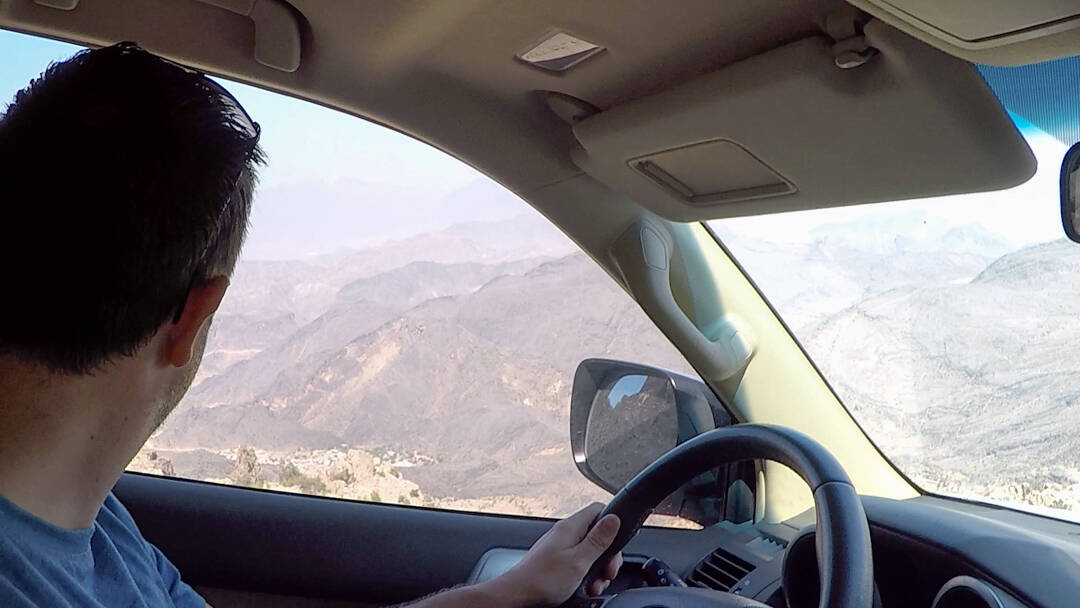
We’re high in the Al Hajar Mountains of Oman, yet – inconceivably – we’re driving through terrain that once made up the ocean floor in a region dramatically sculpted over millions of years by the ever shifting Arabian and Asian continental plates.
And while we’d read plenty of reports of people attempting the Al Hajar mountain pass in a standard two-wheel drive, at this very moment I’m beyond relieved we arranged a 4×4 car rental from Muscat airport for this trip . . . . I suspect Dan will feel the same once she stops yelling instructions at me!
The Al Hajar Mountains Of Oman
Separating the lowland coastal planes that fringe the Gulf of Oman, and Rub ʿal-Khali, Oman’s stark ‘empty quarter’, the Al Hajar mountains quite literally form the backbone of the country’s north.
Stretching for hundreds of kilometres from the Musandam Peninsula to Sur, the Al Hajar mountains draw people from all over the country, keen to wander through date farms, visit ancient mudbrick villages, hike dizzying canyons, and explore the lush wadis.
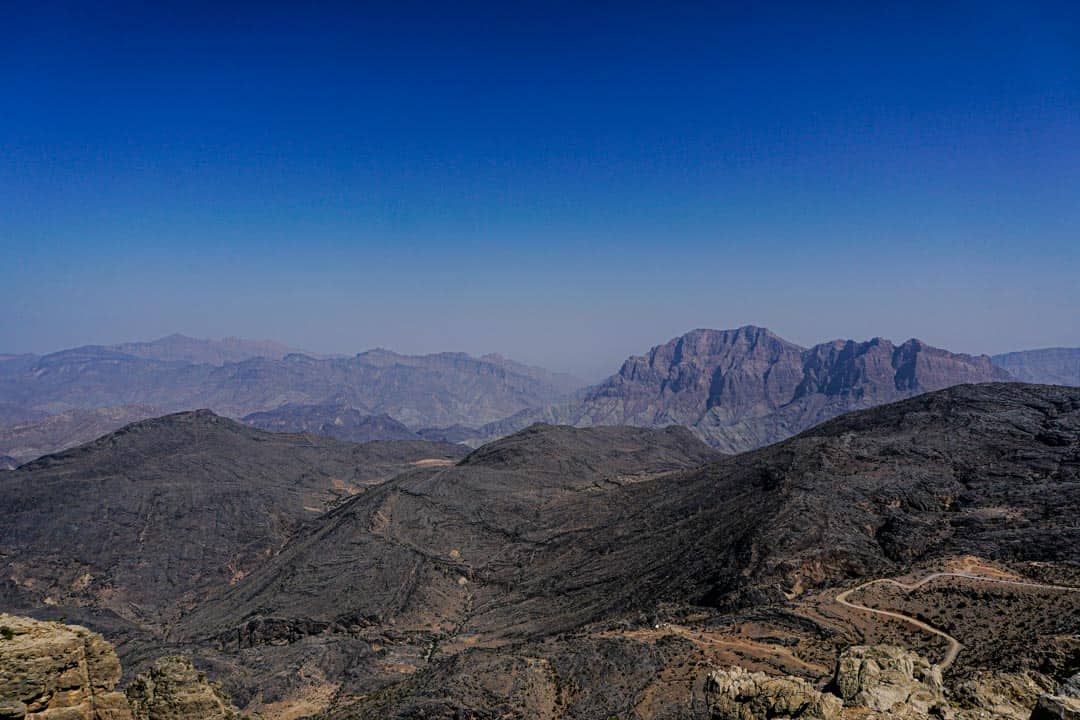
The mountains can be visited on a day trip from Muscat, although we recommend spending time in the ranges to enjoy the cooler climate and spectacular scenery.
Having initially travelled around the mountains via the coast-and-desert route from Muscat to Sur to Nizwa, we decided to loop back to the coast and Muscat by passing over the dramatic range.
So it was that our epic four-wheel drive trip over the Al Hajar mountains, arguably Oman’s best 4WD trip, started in Jebel Shams. This is Oman’s highest peak and a spectacular base for a couple of days taking in the panoramas, and hiking the canyon rim of Wadi Ghul, the country’s own ‘Grand Canyon’.

Leg 1: Jebel Shams To Snake Canyon (Over The Mountain Pass)
Following a quick breakfast at our lovely mountain stay on Jebel Shams, we reluctantly make our way back down the mountain towards Al Hoota Cave. This impressive cave system, the only one you can officially visit in Oman, is a must-see for glimpsing what lies beneath the rocky rise of Jebel Shams.
Either head to the caves for a tour or, if you’ve already visited them, head past the ancient town of Al Hamra on your way from Jebel Shams and take the left turn a couple of kilometres before Al Hoota caves. From there, the paved road will take you to the top of the range.
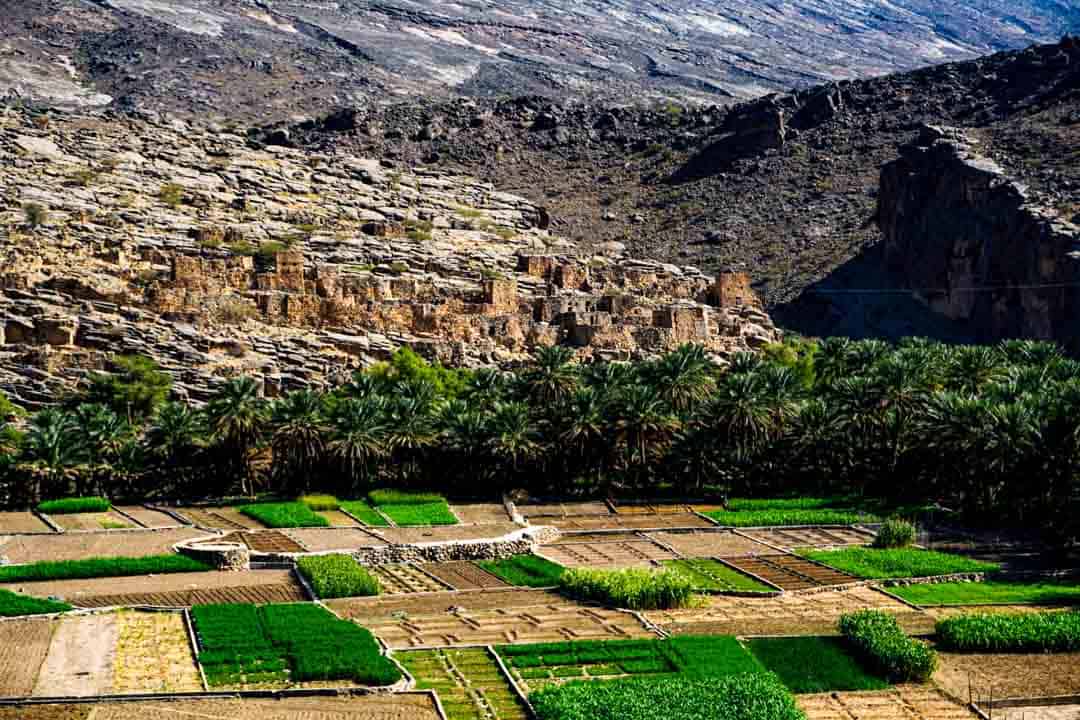
By this stage, having driven the well-maintained paved road, you’d be forgiven for wondering what all the 4WD fuss is about. Don’t worry, you’re about to find out!

From here on, the track turns to dirt, gravel and, in places, a pillowy sand drift: in short, Oman 4×4 driving at its best. The next long stretch is a steep, winding, single track, which makes for some hair-raising moments, especially when cars are coming the other way.
While this is the most challenging leg of the journey from a driving perspective, it’s also the most rewarding: the scenery is without compare. Just don’t look down.
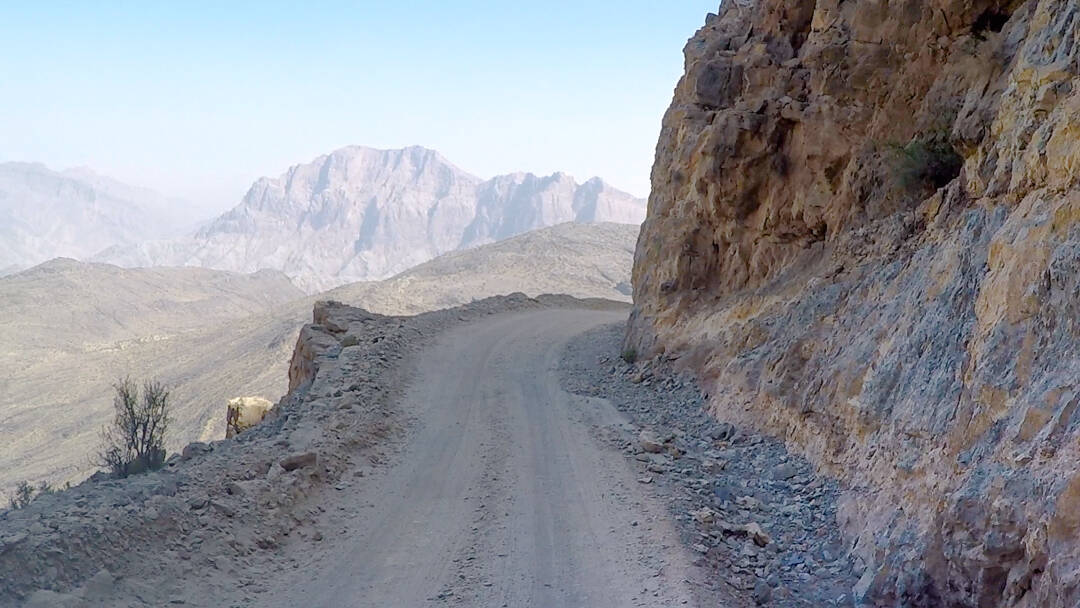
It’s only 75km to Snake Canyon, but this part of our Oman road trip actually takes us around 3 hours, with a couple of brief stops along the way, and some slow, tricky manoeuvring when we encounter other cars.
Thankfully the other drivers we encounter – mostly locals – are courteous, helpful, and patient with our obvious inexperience driving in these conditions.
While the mountains do see some sudden, heavy downpours, it’s dry, parched and hazy when we make the drive over the range. Which makes sights like the vivid green football pitch we pass in the middle of nowhere even more profound. We figure it must be astro turf.
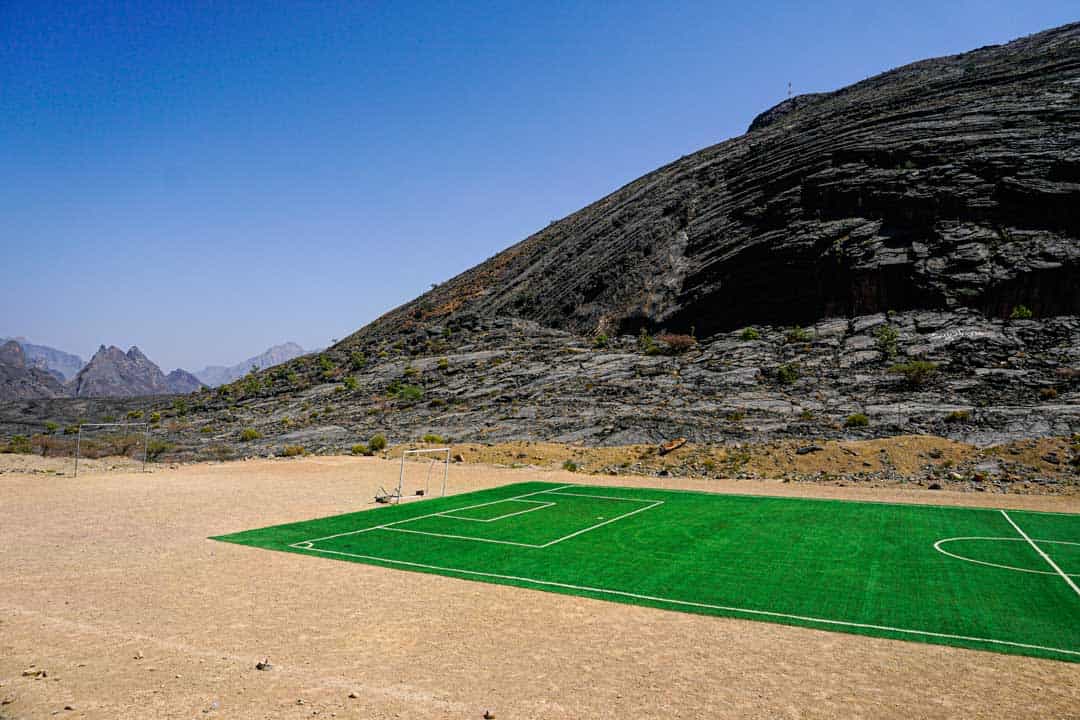
Snake Canyon
Like us, you’ll feel a sense of relief when you finally arrive at Snake Canyon, even though at this point, you may well be too exhausted to realise just how incredible the drive you’ve just completed was.
Snake Canyon is famous in Oman for its beautiful pools, hiking, climbing and abseiling opportunities. Be aware though, it can also be treacherous, and subject to flash flooding in wet weather, with reports of hikers trapped and drowned in previous years.
With two branches, and a 5+ hour, one-way trek through the canyon, it’s not really practical to attempt a thorough exploration as part of this 4×4 journey. If you have time to return, you can explore Snake Canyon on a single or multi-day guided trip from Muscat with an operator or guide familiar with the area
While we don’t get to venture very far into the canyon, it’s still a great place to stretch the legs and calm the nerves after the long drive over the mountain pass.
We recommend taking a short hike over and around the boulders at the entrance of the narrow gorge and enjoying a spot of lunch beneath the trees, before you continue the journey.
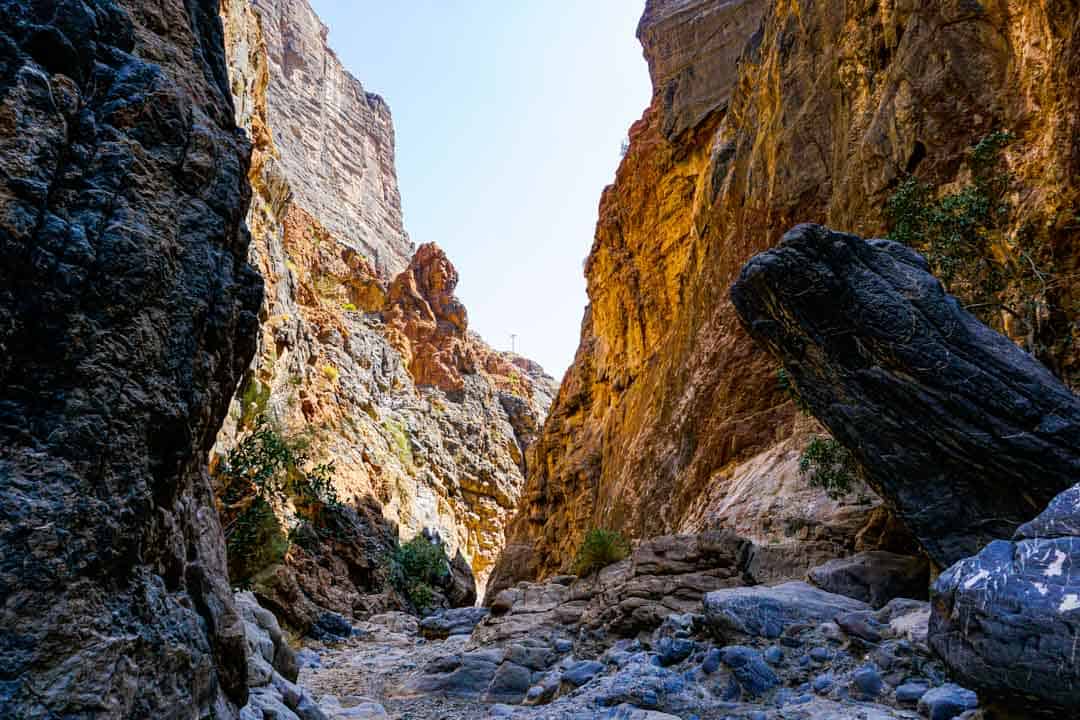
Leg 2: Snake Canyon To Rustaq Fort
The next leg of our journey, which takes around two hours, is through the breathtaking landscapes of Wadi Bani Awf, starting with a dramatic climb that offers birds eye views of narrow Snake Canyon twisting its way into the distance.
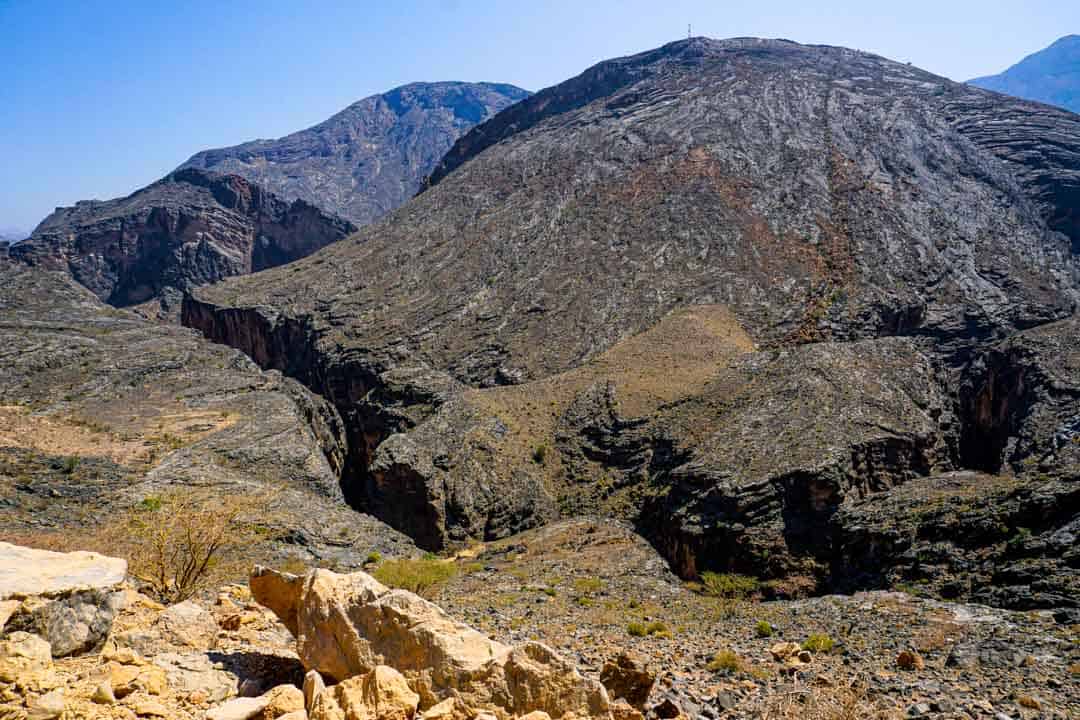
Despite being one of the hottest, driest countries on the planet, Oman is also famous for its many ‘wadis’, an Arabic word for valley.
Often found in arid, desert areas, you’ll be pleasantly surprised to find not only stunning geological formations, but also welcome relief from the heat in the form of inviting emerald pools of cool water.
After the nerve jangling mountain crossing, it’s an easier 50km dirt road drive dominated by soaring limestone peaks, past date palms and ancient falaj irrigation channels.
This is a fantastic stretch of driving through an ancient, dusty landscape that feels completely untouched by the affairs of the modern world beyond.
At one stage, the high walls of the mountains close right in to create a tight, winding path through the wadi. It eventually spits us out into a wide open valley where the sun-baked earth is punctuated here and there by the bright green canopies of hardy acacia trees.
At the village of Al Tikhah, the road becomes paved, and from there, it’s a cruisy ride to the turn-off at Route 13, with stunning mountain scenery along the way.
When you reach Route 13, there are a couple of options to get back to the coast. You can turn left towards Mussanah, past Rustaq Fort, via Route 13 and Route 11 (you can still get back to Seeb and Mussanah this way).
Or go right towards Muscat, passing Nakhl Fort, via Route 13 and the Muscat Expressway or Route 1.
We’re staying tonight in the coastal resort town of Mussanah, so we turn left and make our way to Rustaq Fort.
One of the oldest and largest forts in the country, the restored Rustaq Fort is open until 4pm (11am on a Friday), so if you reach it in time, hike up to its ramparts for awesome views.

Leg 3: Rustaq Fort To The Coast
From Rustaq Fort, we make for the coast via Route 11. If you still have some energy and aren’t castled out, you also have the option of exploring Al Hazm Castle on the way.
You can visit Rustaq Fort, Al Hazm Castle and a third fortress at Nakhl, on a day trip from Muscat. This is sometimes referred to as the Rustaq Loop.
Our hotel for the night is in Mussanah, which is just beyond where Route 11 meets coastal Route 1. If you’re staying in Seeb or Muscat, turn right on to Route 1 and follow it all the way to your destination.
We’ve made it! While the most thrilling section of the drive over the Al Hajar mountains may be the first hair-raising leg in the morning, the vast, dramatic landscapes that follow will have you catching your breath for the rest of the day.
Other Great Oman Off Road Adventures
The Desert Camps Of Sharqiya Sands
While many of Oman’s famed desert camps will collect guests from nearby towns, there’s nothing quite like heading into the great sandy wilderness under your own steam in a self drive 4×4 rental.
Dune bashing is a popular pastime here, and if you’re an experienced off-roader, there’s plenty of fun to be had on the off road tracks that traverse the sands.
As we’re fairly inexperienced in the off road department, especially driving on sand, and not totally convinced of google maps reliability in the desert, we opted to meet our hosts in nearby Al Wasil and follow them to our nomadic desert camp.
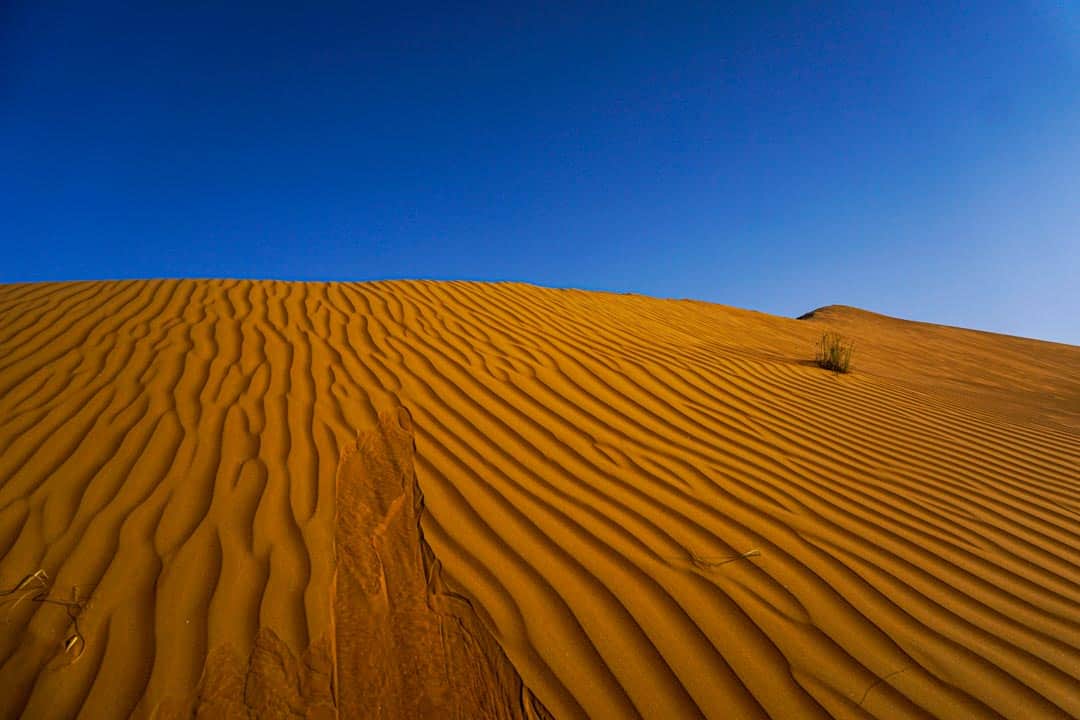
The Beehive Tombs Of Bat And Al-Ayn
Mysteriously strewn across a surreal rocky landscape, these extraordinary structures, of unknown origin or purpose date back more than 4,000 years.
It’s a long, bone jarring drive to the Bat Necropolis on a reasonably well maintained rubbly track, but take it from us, you’ll appreciate having a 4WD rental for the trip.
There are more than a hundred stone structures across a fairly large area here, and while most are in a state of disarray, the site has an eerie, quite ambient feel to it.
You’ll find the Al-Ayn Necropolis back towards Nizwa, better preserved and spectacularly positioned on a rocky outcrop with a mountain backdrop set aflame by the afternoon sun.
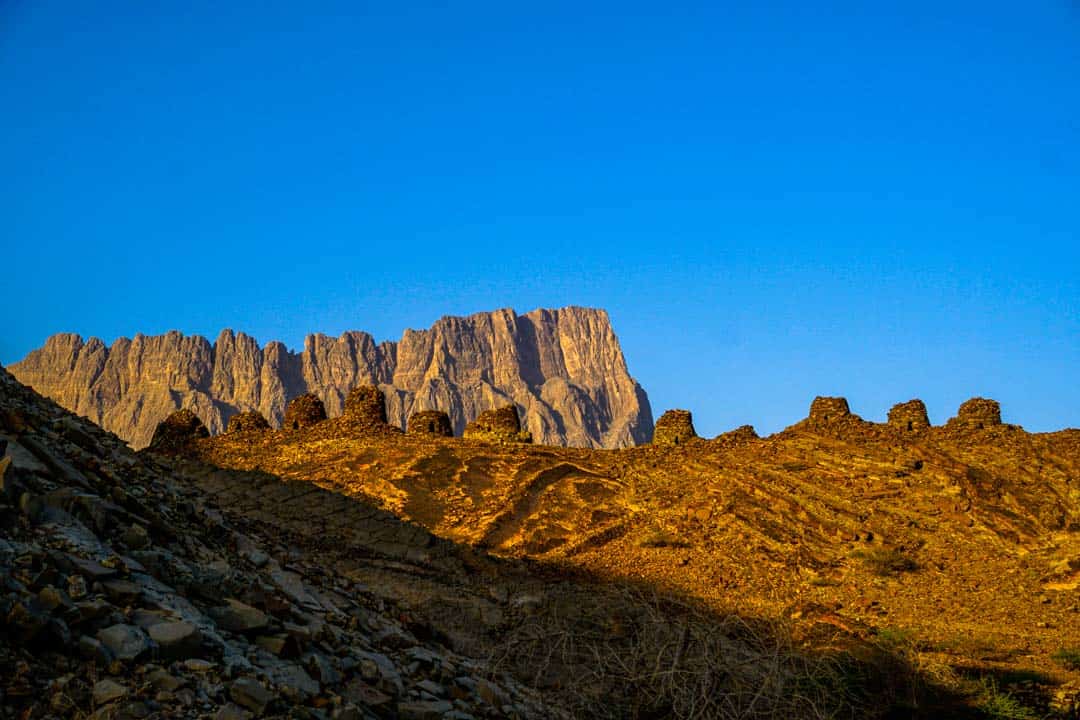
Exploring Oman’s Wadis
While many of Oman’s famous wadis can be reached by a regular two wheel drive, a 4×4 vehicle will give you the freedom to explore some of Oman’s hidden gems.
One such gem lies between Muscat and Sur where a turnoff from the highway snakes through mountains to the emerald waters of Wadi Al Arbeieen.
Not only will you most likely get Wadi Al Arbeieen to yourself, but the stunning drive through the valley to get there is a great way to cut your teeth on Oman’s off road tracks.

Oman 4×4 Rental Considerations
We struggled with our Oman car hire decision for many weeks in planning our trip, and to some degree the answer depends on what you want to do and where you want to go.
Check out our post on planning a trip to Oman for more information about car hire choices, and our self drive Oman itinerary to find out what driving in Oman is really like.
If you’re keen on creating an Oman itinerary that explores the mountains, wadis, and desert areas of the country we’d highly recommend grabbing a 4WD rental. Not only will this allow you to explore more widely, it will also provide a more comfortable ride.
Sound like your kind of 4WD adventure? If you’ve got any questions about the Al Hajar mountain pass or driving in Oman, ask us in the comments below.

Hi Danielle and John..
We will be doing this same trip starting Mar.24th. I am just wondering what you used for GPS to find your way around? Waze or Google maps or ???
Although we have lots of experience with off road driving, I think we will rent a 4×4 just to make sure we are able to get to all the places we want to see..
Thanks for posting your itinerary, looks perfect for us!
Thanks Neil and Shawn
Hi there Neil and Shawn, we’re glad you found this post helpful.
If you haven’t seen them, we’ve also got posts on Planning a Trip to Oman, and a suggested self-drive Itinerary which you may find useful.
We’ve tried both Waze and Google maps in Oman and to be honest, we had fairly mixed results with both, even with a local SIM card.
I think the general consensus from what we’ve read about other peoples experiences, is that Waze works slightly better.
We’ve also seen people suggest printing out daily maps and driving directions as a backup which seems like a sensible fallback.
We didn’t get lost that often thankfully, so hopefully you’ll be fine too.
Have a great trip, and please feel free to drop us a comment afterwards if you had success with any particular navigation app.
Hi,
I took the right turn when coming from Al Haloot when going towards Rustac since Waze suggested it was the best option. And I did have “only paved roads” (or something like that) set in the app, but still got up to the turning point where 4×4, gravel, unpaved, magnificent track starts. Ofc, I was not suitably equipped with a vehicle capable for much off-road activity, namely a small rented Nissan Sunny, front-wheel drive, no clue what engine. Since there were few other cars waiting at the end of paved track, I rushed myself past the BIG RED WARNING sign without bothering to read it.
Next few hours were most beautiful and breath-taking both from driving as well as landscape perspective. After some time I began not to worry about getting up the climbs (mostly it seemed possible to back up and pick up some speed to retry, although I did not need it), but rather descending since it was a rental, not made for hills, and I did not trust the brakes that much.
With a small car it was easier to pass cars coming from front as it would’ve been with an offroader, only one them waved me nuts (which I already had noticed myself) from his window. Near the football field, or wherever there are few houses in the middle of (your) LEG1 and I spotted a local who told me to turn back straightaway since what was about to was much more horrific (for the car and me) than what was behind. Well, I was still hoping to find the paved road that Waze had promised and thought that after the village it will start so I continued. And it didn’t.
But 2nd part was much easier since there seemed to be more descents than climbs. Views continued to be as great as before so it was becoming even enjoyable to certain level. At the riverbed where the last part of this track is, I met an elderly couple of tourists who wished to use the same route in a Toyota Corolla (or whatever midsize Toyota they had) and told them to find another route.
Probably my Nissan managed to take this challenge since I only had a bottle of water in car with me and no luggage nor extra people. With an offroad capable car this track would seem as piece of cake, even when descending so that you only see sky from the front window. But still views are so awesome, only that takes the breath away
Hi there pkr,
Thanks for sharing your experience, we’re glad you enjoyed the drive and managed to get through the route safely.
Your drive sounds pretty hair raising to be honest and makes us glad we opted for a 4×4 vehicle!
Hi! Thanks for sharing your story! We’re planning on an almost identical trip with our two daughters (age 3 and 10 months).
What kind of 4×4 do you recommend? Is a Suzuki Vitara 4×4 suitable, or would we require a more capable car like a Toyota Fortuner or Nissan Pajero?
Also, how dangerous would you rate this road? Is it similar to for instance the infamous Bolivian Death Road?
Thanks!
Michael
Hi Michael! Thanks for reaching out, we’re really glad you found this post helpful.
We hired a Toyota LandCruiser Prado for our trip and it certainly met our needs, not only for this stretch across the mountains, but also for heading across the dunes to Sharqiya Sands, and driving the gravel tracks to some of the wadis and sites like Bat and Al-Ayn. From our observation, Toyotas seemed to be one of the more common 4x4s in Oman.
As we only tend to hire and drive 4x4s when the need arises, we can’t really speak to the suitability of specific makes or models sorry. If in doubt, it may be worth sending your chosen car hire company your rough itinerary or checking out some online forums to see what they suggest?
In terms of the track across the mountains, while it was a little challenging for us in places, mainly on the steep and sandy sections or when we encountered oncoming vehicles on narrow stretches, we don’t think it’s on the scale of the Bolivian road from what we’ve read about that! We just took it slow, drove with care and geeked out over the spectacular landscape.
Safe travels, we hope you and your family have a fantastic trip and enjoy Oman as much as we did.
All the best
John and Danielle
I am sorry, but in your video there is nothing that warrants a 4×4. Did you even engage the 4×4? Yes, maybe you need a high clearance vehicle, and a Chelsea Tractor will do, but there is little in your video excerpt that requires 4×4 in my opinion. A standard 2WD with high clearance such as a Hyundai Tucson should do.
My opinion is that there is so much misinfromation about Oman and the need for 4×4, mostly conveyed by many Europeans not accustomed to dirt road. I would even suggest that a Subaru Sedan could even take up the well graveled dirt road you recorded.
Yes you need 4×4 in some places. Soft sands, compltely off road… but on a graded road in good weather??
Hi there C,
Thanks for sharing your thoughts about this drive, it’s always good to hear different viewpoints.
As you may appreciate, it’s hard to capture every aspect of a drive like this in a short video. It’s intended as a snapshot and part of a post providing a fuller description of our experience driving this route.
While we take your point that in good weather, the drive may well be possible in a standard 2WD with high clearance, we based our choice on the extensive research that we did in advance and personally felt more comfortable with a 4WD.
As we note in the post, while parts of the end-to-end drive are paved, the track over the pass itself is dirt, gravel and sand. While much of this is packed dirt, there were certainly some steep, narrow, sandy sections where we did engage the 4WD and we’re glad we had the option.
We also opted for the car we did (a Toyota Landcruiser Prado) to ensure we didn’t risk voiding our car hire insurance if we travelled on what the hire car operator deemed “off road”, which essentially was anything other than bitumen.
So for us, wanting to drive over this mountain pass safely and comfortably, and also visit places like Sharqiya Sands, the World Heritage sites of Bat and Al-Ayn and some of the wadis which are not accessible via paved roads, meant a 4WD was a better choice for us overall, and gave us the opportunity to see more of this amazing country while abiding by the restrictions imposed on us by our car hire operator at the time.
Again, all of these decisions come down to personal choice based on where you want to go, how experienced you are driving in off-road conditions, and what your car hire arrangements might be.
This post and video are a reflection of our personal perspective on this drive.
If you’ve done this drive in other types of vehicles, please do feel welcome to share more about your experience here. It’s always great for our readers to hear a variety of experiences as this can only help people in making more informed decisions about how they want to travel.
All the best
John and Danielle
Hi Dan, hi John, we made the same trip 2010 with a rented 4×4 Landcruiser driving in opposite direction from the coast to Nizwa. it was no problem for us. We would like to made the same trip with our own 4×4 motorhome on daily 4×4 chassis. The vehicle is 7 x 2,1 x 3,2 (m) and 5.5t. Ist is feasible to make the trip with our beast because of vehicle’s dimension? We are somehow experienced off-road drivers but I don’t remember if the track can be driven with larger vehicles than a SUV. You opinion?
Thanks Paul from Germany
Hi Paul, thanks for reaching out and sorry for the delay in responding. Awesome that you’ve had the chance to travel this route before – you know how spectacular it is! To be honest, we found parts of the mountain pass track hair-raising in a regular 4WD wagon. As you probably remember, there are sections of the pass that are very narrow, sandy and steep. There are also some tight cliff-side stretches and curves that we found challenging, especially when other vehicles were oncoming and we had to reverse until we could find a space wide enough for both vehicles to pass. We don’t recall seeing any vehicles larger than a typical 4WD wagon on our trip. Not sure if you had a chance to watch the video on our post but it shows some of the sections along the way as we travelled over the pass towards the coast – https://youtu.be/VmqMIKowkEI. As we don’t have experience driving larger vehicles like what you’re talking about, we’d definitely suggest seeing if there are any off-roading/4×4 or Oman-specific forums where others may have more experience and insights that can help. Travel safe and enjoy Oman!
Good afternoon,
We are Gerard and Maria Weisscher from the Netherlands, both 73 years old. You made a very nice trip in Oman, passing many off road roads. We will rent a Mitshubishi Pajero with a rooftent. and will travel for 4 weeks in October/November this year. We like very much to discover the Hajar Mountains. Some roads you drove are too challenging for me. We are looking for easy to drive offroad routes . I have little experience with off road driving. May be you can give us some beautiful roads in the Hajar mountains. Please not too challenging.
May be you can also suggest some wadi’s for a beginning offroad driver. We would be very pleased.
Thanks in advance
Greetings from the Netherlands.
Gerard and Maria Weisscher
Hi Gerard and Maria, thanks for your message. Your trip to Oman sounds great – we’re very excited for you! To be honest, with the time we had, and having not done a lot of off-road driving before, we tended to stick to the well-travelled routes for our trip, and most of the ‘off roading’ we did was on clearly laid out packed earth/rubble routes. We were also very mindful of the weather throughout and the fact that wadis can flood unexpectedly.
The crossing over the Al Hajar mountain pass was definitely the most challenging drive we did, but you could still drive through the beautiful scenery on either side of the mountains without having to take on the tricky mountain pass itself.
We really only had time to experience the mountains proper at Jebel Shams, and the drive up there is relatively easy and paved for a good part of the way. Spending time on Jebel Shams was an absolute highlight for us, along with the Wadi Ghul rim hike there.
We recommend checking out some YouTube videos on driving wadis in Oman and in the mountains, so you can see what some of the off-road options are like before you go and what you would be comfortable with – we did this and it definitely helped us decide what routes we would take. As you may have seen in our video of the Al Hajar pass, once we’d made it over the pass to the northern side, the journey to the coast was absolutely spectacular, and a mix of packed dirt and paved road. Honestly, all of the driving in this region is magic.
All the best for a wonderful trip, and happy travels!